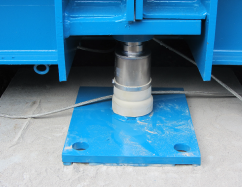Truck Scale Maintenance Guide
A question we’re often asked is “how often does my truck scale require maintenance?”. A thorough check-up of your truck scale every six months at the very minimum is the general rule.
However, it’s important to take into consideration the number of weigh-ins, climate and the value of the product being weighed, as these can all have an impact on the frequency of maintenance your scale needs.
Aside from the actual calibration, most of the inspection will consist of you or your scale technician conducting a visual inspection of the scale, foundation and surrounding area. These are the areas that should be inspected during a truck scale maintenance visit:
Foundation
Even the toughest scale on earth is put at risk if it’s on a poor foundation. Cracked foundations can lead to movement or settling which causes chronic calibration errors.
Any cracks in your foundation should be addressed promptly. If you allow small cracks to become big cracks, it may require removing part or all of the foundation and pouring a new one for the scale to once again be able to function accurately.
Weighbridge
Take a look at the deck. Rust or crumbling concrete can weaken the scale’s structure and cause problems.
Binding is also a common cause of inaccuracies in truck scales. A rock as small as your big toe can become wedged between the foundation and deck. Installing t-strip molding between the two can help keep debris from getting caught or falling down into the scale.
Checking Devices
Some vehicle scales utilize suspension systems that don’t require checking devices, eliminating a time-consuming step in your PM protocol.
If your scale has checking devices, make sure they are working properly. Inspect check rods to make sure the attachment points are solid. Inspect the bindings and hardware to ensure jam nuts are tight and that rods are level and free of debris.
Load Cells
The load cell area may contain dirt and debris that has built up since the scale’s last check. Load cells must have clearance to deflect through their capacity range. The same debris that can bind the scale deck can also keep the load cells and suspension components from moving freely.

You will also want to check load cell cables for damage and if the seal is degraded. To combat this problem, some manufacturers offer rigid or flexible metal conduit to run the cable through, providing a layer of protection that’s nearly impervious to damage from rodents.
Junction Box
Finally, check the junction box for internal condensation as moisture is a common problem. This occurs from normal air exchanges from heating and cooling cycles, and over-aggressive washing that damages sealing components that haven’t been properly maintained. If left unchecked, wiring terminals and other components in the enclosure can corrode.
Depending on your scale’s location, special features and the material it is weighing, your scale inspection may or may not require all of the steps mentioned above. But do them anyway. Your truck scale is a big investment so you want to keep it running for as long as you can.
As the largest service provider of repairs, calibrations and certifications of weigh scale in Ontario, you can count on Active Scale to keep your truck scale running as smoothly as possible. Contact our 24-hour emergency service number toll-free at 1-800-850-8770.